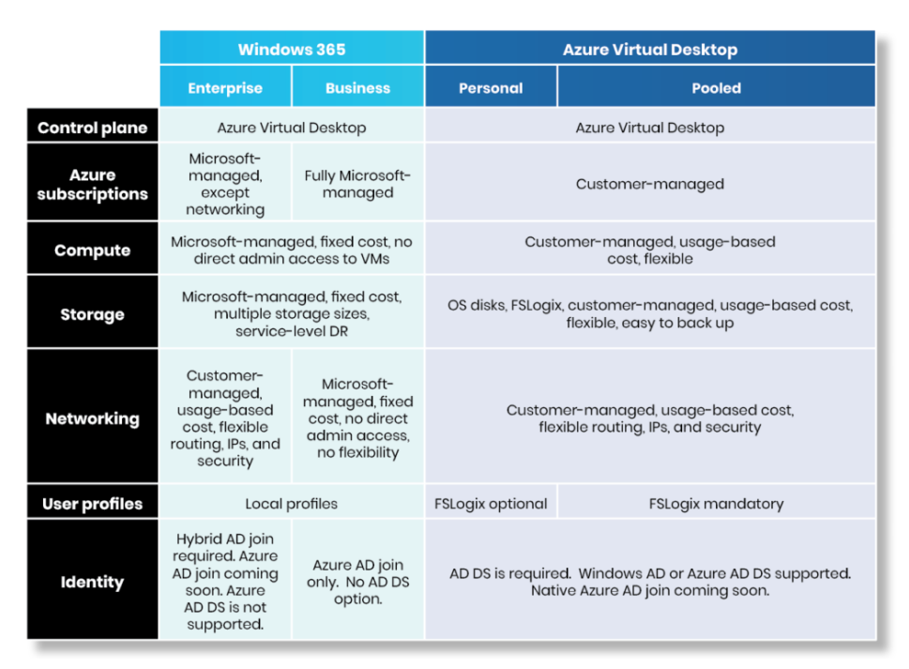For a while now, virtual desktops have helped businesses operate more efficiently, enjoy better security, and offer employees greater flexibility. And with the current ubiquity of remote workers, that flexibility is more important than ever.
But not every virtual desktop solution is designed to solve the same problems. Even if you’re a dedicated Microsoft customer, you’ll need to decide between options like Microsoft Windows 365 and Azure Virtual Desktop (AVD).
To help you determine which one is right for your needs, let’s take a close look at the benefits and drawbacks of each.
Don't want to read the article? Watch the full recording here.
What's the Difference Between Windows 365 and Azure Virtual Desktop?
Windows 365 and AVD are both Microsoft products, but they serve two different needs.
Windows 365 is part of the Microsoft 365 family, which is one of the most popular business productivity platforms in the world. As part of that platform, Windows 365 is Microsoft-managed, which means that it doesn’t allow for much customization and you can’t install custom apps on the platform.
However, if you need to provide an environment for remote or temporary employees, it can be a great option. Especially now, when it’s common for businesses to wait 90 days or more for equipment, providing employees with a Microsoft-managed virtual desktop can be a fast, easy solution.

Azure Virtual Desktop: A Virtual Desktop With Fewer Limitations
On the other hand, if you need something with few limitations and that can accommodate custom applications for your business, then you’ll want to use AVD. AVD lets you fully manage your environment, and it can be easily connected to other devices on premise, servers, and so on.
Another advantage of AVD is that, unlike Windows 365, you don’t have to assign a single user to each workstation. That gives you greater flexibility and makes AVD a better long-term option for your employees.
Of course, AVD and Windows 365 aren’t mutually exclusive. Your business may find use cases for each. For example, you may opt to employ AVD for your full-time workforce while providing Windows 365 to your interns, part-time employees, or employees overseas. There’s nothing to stop your business from enjoying the best of both worlds.
Related Reading: The Ins and Outs of Microsoft Azure Virtual Desktop
How Factors Like Scalability and Compliance Could Affect Your Choice of Virtual Desktops
The size of a business is often a factor in their choice of virtual desktops. For small businesses that have limited IT resources, Windows 365 can be a great option. That’s because Microsoft will manage settings and security, taking those concerns off your team’s plate.
Enterprise-level businesses, which want more control over their virtual environments, will shy away from Windows 365 in favor of AVD. They also tend to have large, well-resourced IT departments, or they’ll retain a managed services provider to help them customize their virtual environments.
Choosing Virtual Desktops While Growing Your Business
In addition to customization concerns, there’s also the issue of scalability. Windows 365 might be a great choice if you have a team of three to five users. But in terms of both price and functionality, economies of scale mean that AVD is the better choice when you have larger teams, or if your business is poised for growth.
AVD is also likely the better option from the perspective of your IT manager. To effectively set widespread permissions or enroll virtual environments in services like Intune or Endpoint Manager, your IT manager needs a virtual desktop that allows for customization. Windows 365 simply doesn’t provide those kinds of options.
Related Reading: Endpoint Detection & Response for Cybersecurity
Compliance Concerns for Virtual Desktops
Finally, an important consideration with virtual desktops is how they conform to compliance and regulatory standards. If you’re in a business like health care, financial services, or any number of heavily regulated industries, you’re going to need full control over your virtual environments to keep them within compliance standards.
In cases like these, Windows 365 won’t be able to give you the flexibility you need, which could put you at risk of running afoul of industry regulations. You’ll be much better off with AVD, which can be customized for compliance.
Managing Virtual Desktops When You’re Not an Expert
Whether you lead a large or small business, you may not have the resources to spare when it comes to managing your virtual environments. For smaller businesses that don’t need customization, Microsoft 365 can be a solid choice: Both the environment and its security are totally managed by Microsoft, which can relieve you of some of the headaches.
On the other hand, if you’re an enterprise-level business or one that depends on custom applications, AVD will be a much better solution. If you need help with management, that’s where Ntiva can help.
We’ll set up the servers and user groups, along with all your user profiles. We’ll also work closely with you to test the virtual environment and make sure it has the programs you need and looks just how you want.
If you have complex data applications, we can set those up in AVD as well to ensure your users have access. Once the environment has all been set up, we’ll provide periodic maintenance for updating applications, service OS, and servers — so you won’t have to be an expert to get the full benefits of your virtual desktops.

